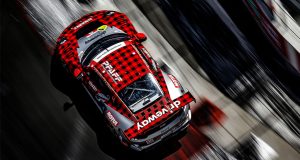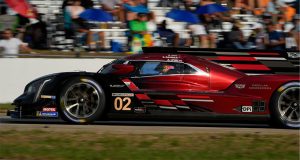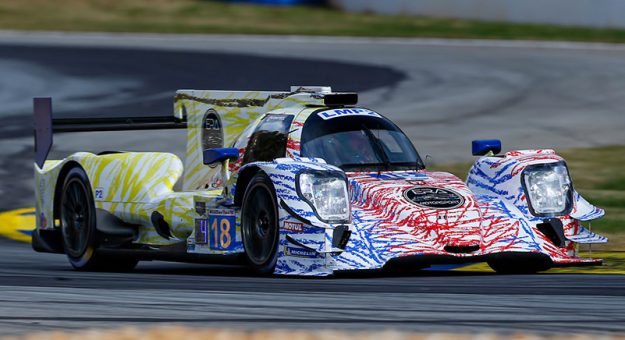While More IMSA Teams Are Using Vinyl Wraps to Display Car Designs, Traditional Painted Liveries Still Exist … and Win
By David Phillips
DAYTONA BEACH, Fla. – Perhaps the most endangered species in motorsports in recent years has been the bodywork painter of race cars. For as their cost and weight have come down, vinyl body wraps – essentially car-sized decals covering the entire bodywork – have increasingly become in vogue throughout the IMSA paddocks.
And why not? In an age when primary, secondary and associate sponsorships can shift race to race, market to market, it makes sense to be able to change a race car’s livery almost as quickly as mechanics can change a windshield tearaway during a pit stop.
“There are so many what are called ‘repurposed paint job’ races – the reliance on individual partners to be featured at individual races,” says Mike Hull, Chip Ganassi Racing’s managing director. “You’ll have an event at say Sebring and then the very next weekend they’re racing with a totally different livery or partner, and you can change the wrap in the field, so to speak.”
Speaking of in the field, when bodywork has been bent, folded and/or mutilated during an incident in practice or qualifying, wraps enable teams to present their cars with a pristine appearance on race day that same weekend.
“If your bodywork gets roughed up, you just basically pull off the wrap and put another one straight on, whereas with painting you have to go through a whole range of steps if you want to refresh it,” says Bryan Herta Autosport team manager Phil Howard. “A wrap is definitely less time-consuming and somewhat more cost-effective.”

Wrapping also enables teams to create and readily duplicate intricate liveries. Take, for example, two of IMSA’s most distinctive looks of late: Pfaff Motorsports’ silver and “tartan” GTD PRO Porsche 911 GT3R and Era Motorsports’ “crayon” Le Mans Prototype 2 car, the latter featuring a design created by young race fan Owen McEachern. Faithfully painting Owen’s design on Era’s ORECA LMP2 07 would have been nigh onto impossible. And yet, Era ran a wrap of that livery in the 2021 Rolex 24 At Daytona, reverted to a more conventional look for the balance of the IMSA WeatherTech SportsCar Championship schedule and then reprised the crayon wrap for the Motul Petit Le Mans season finale.
And if slightly less impossible than duplicating the crayon livery, it would have been tedious in the extreme to paint that tartan plaid on the Pfaff Porsche, let alone its spare body panels.
“I don’t think you find many cars in GTD painted,” says Steve Bortolotti, Pfaff Motorsports’ general manager. “Given all the intricate body work, wraps are just easier to work with.
“(Our) wrap is actually a red vinyl that the plaid is printed on. Then we add the silver. We have templates for the car that we’ve had a few years now, so we’re pretty familiar with the process, which makes it go a lot quicker. The company we use – C17 media – can bang it out in about a day. It’s still a lot of work applying because the patterns have to line up. I’ve tried to do repairs of my own from time to time and made an absolute mess of it, so we leave it to the pros. It’s a simple matter of having a roll of the wrap tucked away in the trailer if we need it.”
But for all the advantages of wraps, paint can still be found on the IMSA grids, and in victory lane. For example, the overall win in the 2022 Mobil 1 Twelve Hours of Sebring Presented by Advance Auto Parts went to Ganassi’s No. 02 Cadillac DPi-V.R. Make that, CGR’s “painted” No. 02 Cadillac DPi.

“Cadillac wanted to create the branding image that everyone saw at Daytona and Sebring,” Hull explains. “We thought we could do a really good job of getting the feel they wanted if we painted them the first time around. And there was a lot of work put into that by our paint shop. They really relished the opportunity because we don’t do a lot of painting at the moment. So, it was refreshing to see the appearance of the cars and how professionally they were presented based on what Cadillac wanted us to achieve, together with them.
“We may wrap the cars as time goes on, it’s hard to say, but the cars looked terrific on the racetrack and we had a lot of compliments off the racetrack, so it was a great exercise for us.”
Although wraps are in the ascendancy, don’t shed too many tears for the painters. While many race teams outsource the creation of their wraps to the same services responsible for some of the gaudy liveries sported by commercial vehicles you see on the street, many teams that once had a dedicated paint shop and painters have transitioned their facilities and personnel to wrapping. Because, for all the talk about the ease and efficiency of wrapping, as much preparation goes into prepping a race car for a wrap job as a paint job.
The next time you attend an IMSA race, look behind the pit boxes and you’ll see replacement noses, wings and tail sections stacked two and three deep. Wrapped or painted? Only a seasoned observer (or a member of the team) can say for sure.
